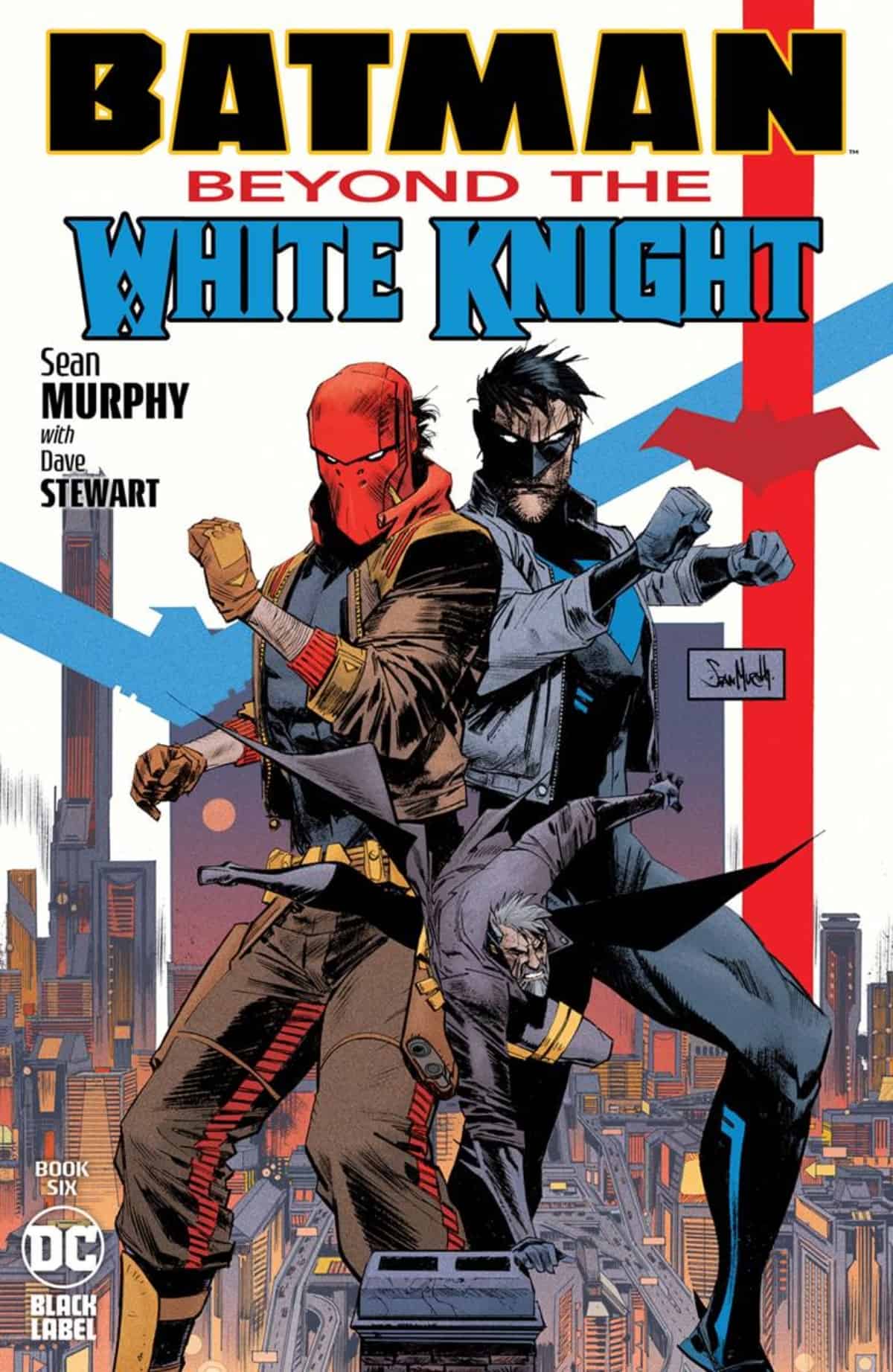Batman: Beyond the White Knight #6

Recap
After years of rivalry, it's the showdown you've been waiting for...Jason Todd versus Dick Grayson! Who's the best Robin? Find out this issue! Plus, with the help of an unexpected new ally, Bruce Wayne aims to take Derek Powers down for good. But will the malevolent millionaire's newfound powers prove to be too much for the former Batman?
Review
Batman: Beyond the White Knight #6 – written and drawn by Sean Murphy, with colors from Dave Stewart, and letters by AndWorld Design – picks up immediately after the last issue’s tender embrace between Harley Quinn and Bruce Wayne controlled by Jack Napier. The issue makes clear that no bat-on-clown hanky panky occurred, and that Jack revealed the situation to Harley, including Bruce’s feelings, hidden as they are. The issue then returns to Bruce’s fight against powers, proving to Dick the man’s plans to weaponize Gotham and Batman while manipulating Terry McGinnis after killing his father. This all occurs after a batfamily blowout between Dick and Jason, which shows just how deep the fractures go in the family. After Dick turns on the GTO and back to the vigilante group, there’s fleeting hope that the family can mend, before tragedy strikes in the form of a cliffhanger.
It’s an interesting narrative choice to pivot from the tropes of a body swamp, ensuring there’re no misunderstandings or soapy shenanigans. That might be a byproduct of the series’s accelerated pace coupled with the packed line-up of characters and concepts. The overall story of Beyond the White Knight feels heavily compressed, even with the additional issues focusing on Red Hood. At six (or eight counting the tie-ins) issues, the amount of story could have easily filled eight to ten, and it might have helped to either split the Beyond concept into two miniseries or at least give it the space of 12 issues.
This issue loses Terry outside of a couple of mentions, and it becomes clear the character has gotten the short end of the narrative focus that should have come with the book’s title. A few more issues showing Terry operating and learning as Batman, interacting with the various elements of Neo-Gotham would have given the character more to do, more organically established the new Gotham, and given the book and its expanded cast a chance to breathe.
Instead, Murphy both stumbles and thrives in places thanks to the accelerated and dense material, working in emotional beats and plot points through his art, creating rich, dense panels and pages that invite multiple rereadings. The density isn’t the same as a book like say Watchmen or a Mister Miracle, but it is a great illustration of Murphy’s skills as a visual storyteller. His use of shadows has been one of the best elements of the entire line of White Knight titles, and that’s never more apparent than in Beyond. The truth about personalities and personas comes out in the shadows, and Murphy could take out the subjects and they would still tell the story masterfully. In this issue, it’s Nightwing’s shadow that steals the show, showcasing the GTO commander still has the acrobat at heart, even as his anger and resentment towards Bruce, Jason, and even Barbara flares.
Murphy chooses to avoid those shadows at one central point, which is when Dick picks up his son from school, and it seems like the choice is signaling that with the child, Dick can break from his shackles of capes and cowls, and just be a father. Murphy dispels the moment the child leaves the panel, showing the outline of Nightwing in the art, ready to move forward and reunite with his adopted family. Murphy expertly indicated this through echoing visuals, utilizing a flashback to Dick’s days as Robin, his relationship and differences with Jason, and then has him embrace the grapple line, a symbol of both Batman, and the acrobat buried deep inside. In the micro, Murphy’s use of these artistic echoes is an excellent choice that builds up the sense of history for this continuity but is frustrating as the writing can’t match the pure level of storytelling instinct.
Stewart’s colors are locked in step with the artistic skill of this issue, utilizing the blacks and grays that have become synonymous with this series to showcase those shadows and the conflicts they represent. Stewart’s colors only stumble in one place, and that’s in the flashback splash page. Specifically, the green of the Dick Grayson Robin costume is faded and hues closer to a dull green rather than the vibrant one associated with the sidekick. The choice makes sense in relation to the rest of the book’s look, but it would have been a great contrast to illustrate the green just as well as the red of the costume. That red worked perfectly for both the shirt of the costume and Barabra’s hair escaping her cowl.
Final Thoughts
Batman: Beyond the White Knight #6 is an interesting but frustrating read thanks to its dense visual storytelling contrasted against the overstuffed plot. The visual elements of the book, including the art, coloring, and use of shadows are all firing at the full cylinder to tell a complex, powerful story of adopted families and the struggle to maintain those relationships. However, the emotional and narrative core are undercut by the overreaching of plot elements and characters that permeate the page. The series could have either used an additional couple of issues or been split up into two miniseries structured like the original White Knight and Curse of the White Knight. This is an issue and series geared towards fans of the batfamily and the Murphyverse, but may continue to disappoint fans of Terry McGinnis and the core Batman Beyond concept.
Batman: Beyond the White Knight #6: Like Fathers, Like Sons
- Writing - 6/106/10
- Storyline - 8/108/10
- Art - 8/108/10
- Color - 8/108/10
- Cover Art - 8/108/10




